BibTeX | RIS | EndNote | Medlars | ProCite | Reference Manager | RefWorks
Send citation to:
URL: http://ijaup.iust.ac.ir/article-1-267-en.html
2- Ph.D.Candidate in Urban Design, Bu-Ali Sina University, Bou Ali Sina University, Janbazan Blvd, 1, LT-65176568978 Hamedan, Iran
As a medium between people and the city, urbanscape makes a mental connection between individuals and their surroundings. It is usually difficult to conceive this mental relationship and its corresponding processes with usual methods. This study seeks to address the mental aspects of urbanscape and highlight its role and importance by using an innovative method.
In this study, map-based methods have been examined as one of the most effective tools for studying citizens’ urbanscape. Indeed, using maps provides a tangible model of the city and its spatial imagination by mapping people’s perceptions. In order to achieve the hidden layers of people’s perceptions, a combination of map-based methods have been examined in the study of Ferdowsi Square in Tehran.
First, 50 questionnaires in which interviewees were asked to draw remarkable element of the area were conducted (Cognitive map). Second, people were asked to mark the places that are meaningful for them in a provided map of the area and describe the reason (narrative map). Finally, the results of the former step as evaluative meaning were measured in investigated area (evaluative map). As the result, collective images completed by narrative maps and 4 categories of meanings attributed to the space have been recognized, collective, individual, physical-functional and sensory-emotional concepts. Moreover, the locations of detailed meanings and the intensity of each meaning or concept have been determined and located on the map. Through analyzing and comparing these maps; it is concluded that by developing map-based methods and combining them with other techniques and methods, deeper layers of individuals’ perception about spaces are revealed. So, spatial distribution of concepts and assessments of individuals that have been provided by these methods in this study seems to be very helpful in analysing mental urbanscape.
In this context, moving from traditional and structured methods to more evaluative and flexible ones that focus on deeper layers of individuals’ perception is extremely useful.

Highlights:
- Developing map-based methods could pave the way for understanding urbanscape more effectively.
- Cognitive maps often provide an image of physical dimensions and structural perception of urbanscape.
- Narrative maps provide us with deeper layers of individuals’ perception of urban environment.
- Evaluative maps help us to find and measure meanings and concepts of a place.
| Rights and permissions | |
 | This work is licensed under a Creative Commons Attribution-NonCommercial 4.0 International License. |




